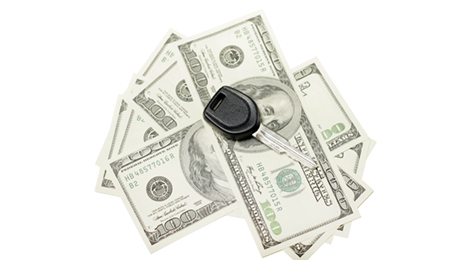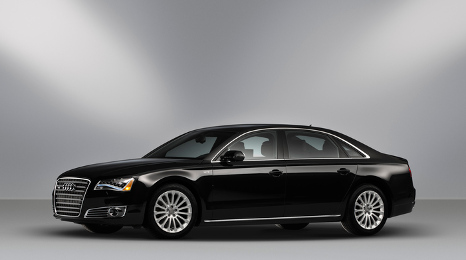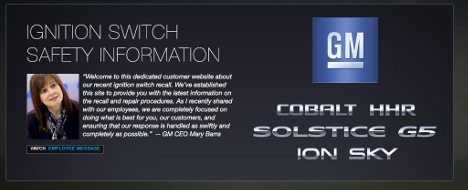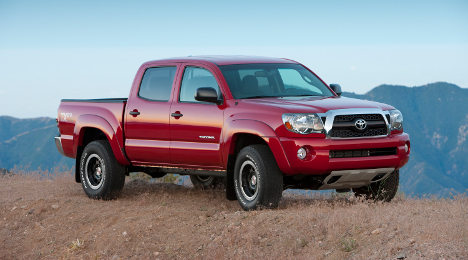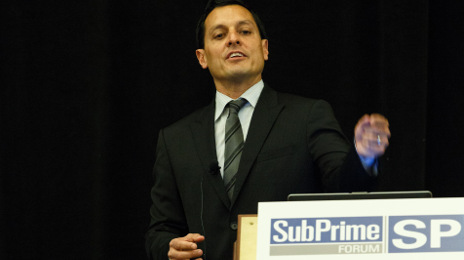It looks like the auction price increases that were predicted to slow after March might stick around for a few more weeks as tax season comes to a close.
According to NADA Used Car Guide, prices in the lanes this week will rise by 0.6 percent, or $100, versus the two-week average.
The biggest spikes are expected in the midsize car segment, which is predicted to see prices rise by 0.9 percent ($125).
Compact utilities and large pickups are also expected to increase, with prices frowing by 0.8 percent and 0.6 percent, respectively.
Trucks saw price strength last week, as well, rising by an average of $51, according to Black Book data. The truck segments continue to impress, remaining in high demand this spring, said Black Book editorial director and senior vice president Ricky Beggs.
Thirteen out of the 14 truck segments saw prices rise last week, according to Black Book.
“This market strength is being led by the very versatile compact crossover utilities at plus-$39 this past week, with this segment now positive week-over-week for four consecutive weeks,” Beggs said.
Going back to the NADA analysis, midsize vans are expected to remain flat this week with no change, and the remaining segments NADA UCG tracks will see slight increases of under 0.5 percent apiece, said David Paris, automotive analyst at NADA UCG.
Though prices remain high, as supply continues to expand this year, prices are expected to continue the annual decline from post-recession highs.
According to NADA Used Car Guide’s 2014 Used Vehicle Price Forecast report released this week, average wholesale prices of used cars and light trucks up to 8 years old will fall by a range of 0.5 percent to 1 percent this year.
The drop is due primarily to an increase in used supply, but the rate of decline will stay modest, says NADA UCG, due to a few macroeconomic factors.
"Economic growth is expected to accelerate to its fastest pace since 2005, keeping demand for new and used autos high," said Jonathan Banks, executive automotive analyst for NADA UCG. "A strong economy, combined with other positive factors, leads to a more positive outlook for used-vehicle prices in 2014."
Four- and two-week AuctionNet wholesale average prices are created by collecting all AuctionNet records for vehicles up to five years of age for a specified period of time. Prices are then adjusted for changes in mileage and mix.
Current week prices are based on NADA's proprietary used-vehicle value model which includes assumptions for new-vehicle prices, used-vehicle supply, gasoline prices, and other economic factors.

| NADA Segment |
Average AuctionNet® Wholesale Price |
2-Week v. Current |
| 4-Week Average |
2-Week Average |
Current Week |
% Change |
$ Change |
| Compact Car |
$11,575 |
$11,650 |
$11,700 |
0.4% |
$50 |
| Compact Utility |
$16,400 |
$16,475 |
$16,600 |
0.8% |
$125 |
| Industry |
$17,225 |
$17,325 |
$17,425 |
0.6% |
$100 |
| Large Pickup |
$23,675 |
$23,850 |
$24,000 |
0.6% |
$150 |
| Large SUV |
$31,525 |
$31,225 |
$31,300 |
0.2% |
$75 |
| Luxury Car |
$24,000 |
$24,100 |
$24,225 |
0.5% |
$125 |
| Luxury Utility |
$27,475 |
$27,700 |
$27,850 |
0.5% |
$150 |
| Mid-Size Car |
$13,600 |
$13,675 |
$13,800 |
0.9% |
$125 |
| Mid-Size Utility |
$20,525 |
$20,675 |
$20,700 |
0.1% |
$25 |
| Mid-Size Van |
$17,125 |
$17,225 |
$17,225 |
0.0% |
$0 |
Used prices are spiking as of late due in part to the regular surge in demand during tax season. However, as supply continues to expand this year, prices are expected to continue the annual decline from post-recession highs.
According to NADA Used Car Guide’s 2014 Used Vehicle Price Forecast report, average wholesale prices of used cars and light trucks up to 8 years old will fall by a range of 0.5 percent to 1 percent this year.
The drop is due primarily to an increase in used supply, but the rate of decline will stay modest, says NADA UCG, due to a few macroeconomic factors.
"Economic growth is expected to accelerate to its fastest pace since 2005, keeping demand for new and used autos high," said Jonathan Banks, executive automotive analyst for NADA UCG. "A strong economy, combined with other positive factors, leads to a more positive outlook for used-vehicle prices in 2014."
Auto loan interest rates for new vehicles were at their lowest level in at least 40 years in 2013, while lender willingness to extend credit was also very high, he added.
"We expect credit to have a slightly less positive effect on used prices as they begin to normalize, but the credit environment will still remain very strong," Banks said.
As always, supply trends will play a large role in how used price changes pan out this year.
According to the report, the supply of units up to five model years in age will grow by 8 percent to 9.6 million units in 2014.
And off-lease volume is expected to continue spiking — and these cars are typically a direct feed to many manufacturers’ CPO programs.
Off-lease volume is estimated to have grown by nearly 15 percent in 2013, and is expected to increase by an additional 18 percent — or 300,000 units — this year, while rental supply is expected to rise by 6.6 percent or 104,000 units, according to NADA UCG data.
The report says late-model used vehicles will be in higher supply, but rates will still stay below pre-recession levels this year.
“Last year's 15.4-percent rise in manufacturer certified pre-owned vehicle sales, predominantly derived from this age group, indicates there will be a strong appetite for these units,” Banks said.
Factors like these will serve to cut down on the level of downward price pressure normally associated with higher supply.
"A decline in the supply of older models along with greater demand for older used vehicles in recent years will keep prices high," Banks said.
Overall, NADA expects that new market pressure and a higher supply of used vehicles will lead to a more substantial 1- to 2-percent decrease in prices for 1- to 5-year-old vehicles.
On the other hand, the report states that tight supply of 6- to 8-year-old units will result in prices being flat or rising slightly. For these older models, NADA expects supply will fall by 11 percent this year.
As far as segment change goes, NADA said annual changes in price will remain largely influenced by supply levels.
Subcompact, compact and luxury midsize cars — segments which tout historically higher supply of late-model vehicles — will see the largest price slides this year, NADA predicts.
Trends on the new-car side of the business aren’t expected to have much impact on used prices in 2014.
Though NADA is predicting that incentives for new vehicles will rise slightly this year, manufactures “more discrete” use of cash incentives and higher all around new-vehicle prices will cut down on potential downward pressure on used prices.
However, Banks cautioned that attractive lease and finance promotions combined with an improving economy may guide more consumers toward new purchases rather than used.
Editor’s Note: For more insight from NADA Used Car Guide’s “2014 Used Vehicle Price Forecast report,” stay tuned to Auto Remarketing Today.
Two weeks ago, the proportion of price adjustments in lanes that were positive rose to a yearly high of 68 percent. Now, the bar has been pushed even higher, says Black Book’s Ricky Beggs.
In his latest “Beggs on the Used Car Market” video report, he said that last week, over 71 percent of all price changes at auction were increases.
Another sign of a particularly strong auction market: for the first time this year, the overall segment change for both cars and trucks finished at positive levels.
The truck segments ended with an average increase of $51, while cars saw a slight increase of $1.
Prices are up, and the market is strong, says Beggs.
One comment Black Book received from a dealer last week illustrated the auction environment well: “There was a buyer for whatever crossed the block.”
The truck segments continue to impress, remaining in high demand this spring, said Beggs.
Thirteen out of the 14 truck segments saw prices rise last week.
“This market strength is being led by the very versatile compact crossover utilities at plus-$39 this past week, with this segment now positive week-over-week for four consecutive weeks,” Beggs said.
And for the first time in the past three weeks, increases were seen in both the full-size van segments and also the full-size SUVs.
The only segment to see a drop in price was the luxury SUVs with a decline of $33.
For pickups, this is continuing the price strength trend seen in 2013. Due to what NADA Used Car Guide's Jonathan Banks says was a “unique combination of both consumer and commercial demand along with lower gas prices and comparatively tight supply,” large pickup price increases led the pack in 2013.
Last year, the segment saw their values rise 9.6 percent over 2012 levels , according to NADA UCG data released in January. Throughout 2013, pickups enjoyed much stronger price retention than other segments, and were not affected by seasonal downturns. The trend seems to be continuing into the new year.
The cars are showing positive consistency in the lanes, as well.
Moving back to the Black Book analysisl, six of the 10 car segments saw positive price increases last week. And Beggs pointed out that every segment that saw price increases this past week has now seen multiple consecutive weeks of positive change.
The entry level cars, entry mid-size cars and the upper mid-size cars have seen price increases for the past five weeks in a row.
Wholesale prices are still on the upward swing as March comes to a close and we near the end of tax season, according to AuctionNet data provided to Auto Remarketing. Meanwhile, pre-owned retail prices observed on Cars.com seem to have been on a different track.
According to Cars.com data, overall used prices on the site have held “mostly steady” this month, down just $6 to an a average of $23,243.
On the other hand, wholesale prices continue to spike, as NADA Used Car Guide is predicting auction prices to rise this week by an average of 0.3 percent (or $50) versus the two-week average.
Breaking it down by segment, the wholesale results are a bit of a mixed bag.
The biggest price increase is expected in the midsize utility segment, which is predicted to see rates rise by 1 percent ($200).
Large pickups, which continue to see strong price retention, will come next with an expected rise of 0.8 percent ($200), followed by midsize and compact car segments with 0.7-percent and 0.6-percent gains, respectively.
For pickups, this is continuing the price strength trend seen in 2013. Due to what NADA UCG’s Jonathan Banks says was a “unique combination of both consumer and commercial demand along with lower gas prices and comparatively tight supply,” large pickup price increases led the pack in 2013.
The segment saw their values rise 9.6 percent over 2012 levels last year, according to NADA UCG data released in January. Throughout 2013, pickups enjoyed much stronger price retention than other segments, and were not affected by seasonal downturns. The trend seems to be continuing into the new year.
Midsize vans and compact utilities are expected to increase this week, as well, but their respective gains of 0.4 percent and 0.2 percent are expected to “hover around the industry average,” said David Paris, automotive analyst at NADA UCG.
Though some of the heftier vehicles, such as the large pickups, are showing price strength, the story isn’t quite the same for their SUV counterparts.
NADA UCG expects large SUVs to see the biggest price drops this week, falling by 0.5 percent ($150).
Declines are also expected in both the luxury car and utility segments, although drops will be small at 0.1 percent and 0.2 percent, respectively.
On the retail side of the business, luxury units are also seeing price declines across the board. According to the latest post on the Cars.com "Kicking Tires" blog, which was written by Mike Hanley, models from luxury brands accounted for seven of the top 10 used cars with the biggest price drops this month.
The list included models such as the Audi A8, coming in at No. 3 with an average selling price of $63,171 as of March 1 — which marks a 2.4-percent drop from Feb. 1 rates.
Interestingly, though used-luxury prices dropped the most in February as far as segments go, one fuel efficient model saw the largest individual price fall-out.
The Chevrolet Volt extended-range electric car experienced the biggest price drop. It was down 3.1 percent ($811) to $25,000.
“This winter has not been kind to used Volt prices, which are down 10.5 percent ($2,922) since Dec. 1, 2013,” Hanley wrote in the blog.
To see the original Cars.com blog post and check out which luxury units saw the biggest retail price drops last month, see here.
Four- and two-week AuctionNet wholesale average prices are created by collecting all AuctionNet records for vehicles up to five years of age for a specified period of time. Prices are then adjusted for changes in mileage and mix.
Current week prices are based on NADA's proprietary used-vehicle value model, which includes assumptions for new-vehicle prices, used-vehicle supply, gasoline prices, and other economic factors.

| NADA Segment |
Average AuctionNet® Wholesale Price |
2-Week v. Current |
| 4-Week Average |
2-Week Average |
Current Week |
% Change |
$ Change |
| Compact Car |
$11,500 |
$11,675 |
$11,750 |
0.6% |
$75 |
| Compact Utility |
$16,300 |
$16,475 |
$16,500 |
0.2% |
$25 |
| Industry |
$17,100 |
$17,275 |
$17,325 |
0.3% |
$50 |
| Large Pickup |
$23,450 |
$23,725 |
$23,925 |
0.8% |
$200 |
| Large SUV |
$31,575 |
$31,600 |
$31,450 |
-0.5% |
($150) |
| Luxury Car |
$23,850 |
$23,900 |
$23,875 |
-0.1% |
($25) |
| Luxury Utility |
$27,275 |
$27,450 |
$27,400 |
-0.2% |
($50) |
| Mid-Size Car |
$13,550 |
$13,625 |
$13,725 |
0.7% |
$100 |
| Mid-Size Utility |
$20,450 |
$20,650 |
$20,850 |
1.0% |
$200 |
| Mid-Size Van |
$17,100 |
$17,075 |
$17,150 |
0.4% |
$75 |
As Capitol Hill hearings about the recalled units get closer, NADA Used Car Guide indicated wholesale prices for vehicles included in the General Motors ignition switch controversy haven’t moved much beyond industry averages.
Analysts told Auto Remarketing on Wednesday that prices for the 2005 through 2007 Chevrolet Cobalt changed little based on data through March 17. The range went from a 0.7-percent dip for the 2007 model to a 0.6-percent uptick for the 2006 model.
NADA UCG also mentioned price movement for other recalled models — including the Chevy HHR, Pontiac G5 and Saturn Ion — has been similar to what’s been recorded on the Cobalt, “meaning, there’s been no evident drop-off. Prices have either been flat or up.”
By comparison, analysts pointed out prices for all 2007 model year compact cars fell by 1.8 percent.
“So Cobalt prices haven’t moved any more acutely than prices for the compact car segment as a whole,” NADA UCG said.
“Again, please keep in mind the low starting price associated with older vehicles leads to more pronounced changes in percent terms,” analysts continued. “Also note that the more extreme change in overall compact car segment prices could be due to changes in mix (meaning, a larger proportion of cheaper or rougher condition models being sold at auction).
“Similar to what was stated last week, it doesn’t appear as if GM’s ignition switch recall has had a discernable impact on wholesale auction prices of affected models to date,” they went on to say.
NADA UGC also reiterated that outside of industry media, the GM recall of more than 1.3 million older units doesn’t seem to be getting much play.
“Headlines continue to be dominated by Malaysia Airlines Flight 370 and Russian action in the Ukraine. This is likely helping recalled model prices at the moment,” analysts said.
That media attention is likely to change next week when GM chief executive officer Mary Barra testifies during hearings hosted by both the U.S. House and Senate.
Sen. Claire McCaskill of Missouri is chairman of the Senate Commerce Committee’s Subcommittee on Consumer Protection, Product Safety and Insurance. The subcommittee has jurisdiction over several federal agencies, including the National Highway Traffic Safety Administration.
“We have to get to the bottom of this,” McCaskill said. “We need to find out who dropped ball and put millions of Americans at risk. We also need to make sure that General Motors and federal regulators are doing everything they can to prevent more tragedies like this now and in the future.”
Barra has apologized multiple times for the entire situation, which has been tied to more than 12 deaths. This week, the automaker rolled out a special website dedicated to the recall. Vehicle owners who visit www.GMIgnitionUpdate.com will find details about the vehicle recalled, when replacement parts will be available and phone numbers owners can call to ask more questions.
“Our focus is on making this recall go smoothly for all of you who are affected and to make sure we improve our process so this does not happen again,” Barra said Wednesday in a blog post on the automaker’s website.
The percentage of price increases for vehicle segments flowing through the lanes this past week continued to grow, hitting the highest level seen over the past 12 months. This prompted some dealers to predict we might see another month of positive values before settling into a more stable auction market.
According to Black Book’s Ricky Beggs, the percentage of price adjustments for auction prices last week grew to almost 68 percent, which marks the highest level of any week over the past year.
He said in latest “Beggs on the Used Car Market” video report that the number of price changes grew at a quick pace, averaging 1,783 per day, which marks the second highest rate this month.
The truck market continued to impress, finishing off the week with an average increase of $15 across the segments, which marks the highest increase over the past 12 months.
With 10 of the 14 truck segments increasing for the week, the strongest individual segment increase was the $51 spike seen among the compact crossovers, which are now on a three-week run of increasing values, Beggs reported.
Cars also put up a strong showing, with an average segment decline of $9. This is the lowest level of week-over-week change since April 5, 2013, when there was less than a dollar decline.
Six of the 10 car segments saw increasing values, as well.
Last week, Beggs pointed out another indicator of continuing strength in the lanes: out of the 24 total segments Black Book tracks, only five saw lower prices than the week prior.
"The positive run in the strengthening market really covers the past month,” said Beggs. “During that time, 14 segments actually increased in value, led by the entry level cars at 2.6 percent, while only one segment declined an above average amount, the prestige luxury cars at -2.1 percent.”
Last month, NADA Used Car Guide kicked off a two-part series on vehicle value retention in its NADA Perspective report with a close look at passenger car segments. On Friday, NADA UCG followed that up by diving into value retention for light-duty trucks and SUVs.
According to its analysis, the truck segment with the strongest retention was the large pickup at 62.5 percent and the individual model with the best retention was the Toyota Tacoma at 80.7 percent.
Here’s how NADA UCG went about determining retention levels, as noted in the report:
Retention figures were calculated for the most prevalent trim level of 3-year-old light duty trucks and SUVs (2011 model year), with results ranked in descending order within a given segment. For the purposes of this review, retention is a function of a three-month average (Jan. 2014 – Mar. 2014) of NADA’s average trade-in value divided by a vehicle’s typically-equipped Manufacturer Suggest Retail Price (MSRP). Note that a given vehicle’s rate of depreciation, and thus retention, is in part a product of the level of discounting at the time of new sale. As such, the MSRP does not include any incentives or rebates available at the time of purchase.
Starting off with the leader, large pickups (half-ton) haul in “tremendous demand” and the strongest retention of any truck segment. They are led by the Toyota Tundra with 71.6 percent retention.
“Large pickups have continued as a staple of the automotive diet in the United States for decades as many Americans have a penchant for vehicles with size, power and off-road capability, offering greater utility than other products on the market,” NADA indicated.
“As their fuel economy improves and the numbers of trim levels increases, including the expansion of option choices that now reach luxury territory, large pickups are currently available with more variety than ever, which has led to ever-growing sales,” the analysis continued.
As for compact utility vehicles, the analysis found these models retained 56.6 percent of their value on average. This was a better rate than all of the car segments, NADA indicated.
“Asian compact utilities, similar to many of the car segments, have the highest retention levels with the top seven models all either Japanese or Korean,” the report stated. “What stands out for compact utility vehicles as opposed to the car segments, however, is the highest retaining compact utilities are largely different from the biggest sellers.”
The midsize utility segment commanded 55.5 percent retention, which was also better than any of the car segments, NADA said.
Several of the top-selling midsize utilities also had the some of the best retention scores within the segment: the Ford Explorer, Jeep Grand Cherokee, Toyota Highlander and Honda Pilot are among the top five best-selling midsize utilities and all four are also rank in the top six of this segment for retention, according to NADA.
Continuing on, the midsize pickup segment had the second-best score among the truck segments with 61.1 percent average retention. The segment boasts the aforementioned Tacoma, which leads all trucks in maintaining its value.
Meanwhile, average retention for large SUVs is at 57 percent and midsize vans are at 49.2 percent.
Moving over to the luxury side of the truck market, both the luxury compact utility segment and the luxury large SUV segment took 59.6 percent retention scores.
Luxury compacts were led by the Audi Q5 (67.8 percent) and the top luxury large SUV was the Toyota Land Cruiser (69.9 percent).
“Since Toyota is not a luxury brand, some may question why the Land Cruiser is placed in the luxury large SUV segment, but its 2011 MSRP of $69,120, not including destination, makes it a direct competitor to other models in the luxury sector,” the analysis explained.
“Since its creation back in 1951, the Land Cruiser has been a symbol of utility and ruggedness for the brand and is currently the longest running series in Toyota history.”
As for the luxury midsize utility segment, retention is at 55.7 percent.
Lastly, hybrid truck and SUV retention was at 54.3 percent on average. Two of the three leaders here are from Toyota: the Highlander (64.4 percent) in first and the Lexus RX in third (58 percent).
“Similar to what we have observed in other SUV and truck segments, Toyota’s vehicles have generally performed very well because of their composition of build quality, efficiency and overall value,” analysts said. “Toyota has been a significant player in the hybrid sector for a long time, and the Highlander hybrid is no exception.”
The complete report can be read here.
Wholesale prices are projected to climb just under 1 percent this week, and four segments are expected to move up even more than that, according to AuctionNet data provided to Auto Remarketing by NADA Used Car Guide.
NADA is anticipating that AuctionNet wholesale prices this week will climb 0.9 percent (or $150) against the two-week average and settle at $17,300. And eight of the nine segments in its data set are expected to increase, as well.
Compact cars are predicted to climb 1.5 percent ($175), with compact utilities growing 1.2 percent ($200), midsize utility prices also increasing 1.2 percent ($250), and midsize car prices jumping 1.1 percent ($150), according to NADA.
Prices for large pickups (up $175) and large SUVs (up $225) should each climb by 0.7 percent
Luxury cars (up $125) are projected to increase 0.5 percent, as are luxury utility vehicles (up $150).
Midsize vans are projected to be the lone decliner, falling 0.3 percent ($50) in price.
Four- and two-week AuctionNet wholesale average prices are created by collecting all AuctionNet records for vehicles up to five years of age for a specified period of time. Prices are then adjusted for changes in mileage and mix.
Current week prices are based on NADA’s proprietary used-vehicle value model which includes assumptions for new-vehicle prices, used-vehicle supply, gasoline prices, and other economic factors.

| NADA Segment |
Average AuctionNet® Wholesale Price |
2-Week v. Current |
| 4-Week Average |
2-Week Average |
Current Week |
% Change |
$ Change |
| Compact Car |
$11,350 |
$11,550 |
$11,725 |
1.5% |
$175 |
| Compact Utility |
$16,125 |
$16,350 |
$16,550 |
1.2% |
$200 |
| Industry |
$16,900 |
$17,150 |
$17,300 |
0.9% |
$150 |
| Large Pickup |
$23,325 |
$23,475 |
$23,650 |
0.7% |
$175 |
| Large SUV |
$31,450 |
$31,800 |
$32,025 |
0.7% |
$225 |
| Luxury Car |
$23,750 |
$23,925 |
$24,050 |
0.5% |
$125 |
| Luxury Utility |
$27,150 |
$27,325 |
$27,475 |
0.5% |
$150 |
| Mid-Size Car |
$13,425 |
$13,575 |
$13,725 |
1.1% |
$150 |
| Mid-Size Utility |
$20,275 |
$20,450 |
$20,700 |
1.2% |
$250 |
| Mid-Size Van |
$17,000 |
$17,050 |
$17,000 |
-0.3% |
($50) |
Dealers are scouring the lanes trying to find inventory to prosper during tax season. The daily result is that Black Book editors are seeing some of the highest levels of price adjustments.
Black Book editorial director Ricky Beggs shared in his weekly online video commentary that since the first of February, editors have averaged 1,820 adjustments per day with the lowest daily average during any one week being 1,619.
Beggs highlighted that editors recorded 2,150 adjustments per day this past week, representing the second-highest level since the week ending Dec. 13, which was the peak level for the past year at 2,380 per day.
“The difference between the two most active high water mark weeks was that in last December, only 27 percent of the adjustments were increases, and this past week at 56 percent, you are able to see not only the tremendous activity, but the overall strength in the market,” Beggs said during his latest edition of “Beggs on the Used Car Market.”
Beggs noted another sign of a very active market: Black Book noticed activity in four segments where more than 30 percent of all models within that specific segment posted increasing price adjustments, led by 46 percent of the entry-level cars.
“Counting all adjustments, increases and decreases, the entry level cars segment had 62 percent of all models adjusted,” Beggs said. “This was only topped by the 63 percent of all full-size pickups being adjusted, including increases and decreases.
“All told, eight of the 24 segments tracked and reported by Black Book had at least 40 percent of the vehicles listed in those segments adjusted. What an active and moving market,” he went on to say.
While the daily price adjustment levels are keeping editors busy, Black Book reported car prices softened more last week than they did a year ago.
Beggs indicated the overall average price change for cars came in at a decline of $18, more than the same week a year earlier when car prices softened $8. He mentioned it was also the lowest declining amount since the week ending April 26 of last year when the price decline was $14.
For three consecutive weeks Black Book noticed prices for entry level cars, entry midsize cars and upper midsize cars have had weekly increasing changes.
“Each of these three segments was also weekly increases for the year ago period,” Beggs said.
On the truck side, Black Book said average prices for these units dipped by $10 for the second week in a row, slightly more than the same week a year ago when the price decline was $7.
“This past week six truck segments had increasing weekly changes with only the compact crossovers having back-to-back weekly increases,” Beggs said. “One year ago there were also six increasing segments of which the compact crossovers were increases then as well.”
As he has for several weeks, Beggs wrapped up his weekly commentary by dissecting another element of why tax season is one of the most unique times in the wholesale market.
“Oftentimes we see and talk about seasonality within the market. If there is one point in time each year that is a constant in movement direction and amount, it has to be the current tax season market. The results of the market this past week are so similar to the level of changes one year ago,” Beggs said.
“I know there continues to be blasts of cold weather in many parts of the country, but here in the Southeast there are very small signs of spring about to blossom,” he continued. “Daylight saving time has brought us longer evening hours of sunlight, which often keep the open sign on the showroom door longer each day. This might be what keeps the tax season going and even more activity within the new car markets.
“We will be back on the auction lanes this week to see if the market strength continues,” Beggs went on to say. “And if this next week tracks similar to year ago levels, the market will react even better. March madness is happening in the lanes as well as the hard courts.”
With trees starting to bud in some places and college basketball fans ready to fill out NCAA Tournament brackets, analysts from NADA Used Car Guide are seeing positive signs of spring for dealers, too.
Executive automotive analyst Jonathan Banks articulated several specific points in his market overview video for March.
“NADA expects the uptick in auto demand with the receiving of tax refund checks coupled with better weather will create strong demand for both new and used markets in the upcoming month. In fact, AuctionNet data from the first week of March is outpacing NADA’s forecast, which predicts used prices rising by an additional 1 percent,” Banks said.
“This pent-up demand from the weather may prove to push seasonal gains out a bit farther than the seasonal patterns we saw last year,” he continued.
Earlier in the video presentation, Banks touched on two vehicle segments that are performing differently than NADA UCG expected.
“On an annual basis, large pickup and SUV price growth continues to overshadow the rest of the market and our expectations. Supported by consistent gains in 2013, the respective prices are up 10.6 and 6.5 percent respectively on a prior-year basis,” Banks said.
Banks also recapped February’s used-price movements, reiterating the impact harsh winter weather had.
“February proved that weather was a primary obstacle for vehicle demand. Extremely cold weather in the first two weeks of the month and more moderate temperatures in the second half correlated exactly with used-price movement,” he said.
“Used prices grew by 0.7 percent over the first half of the month and as weather become more favorable, prices grew by an additional 1.5 percent to a total of 2.2 percent by month’s end. This movement followed NADA’s expected seasonal trend, which resulted in NADA’s seasonally adjusted used-price index remaining unchanged for the third month in a row at 124.6,” Banks went on to say.



